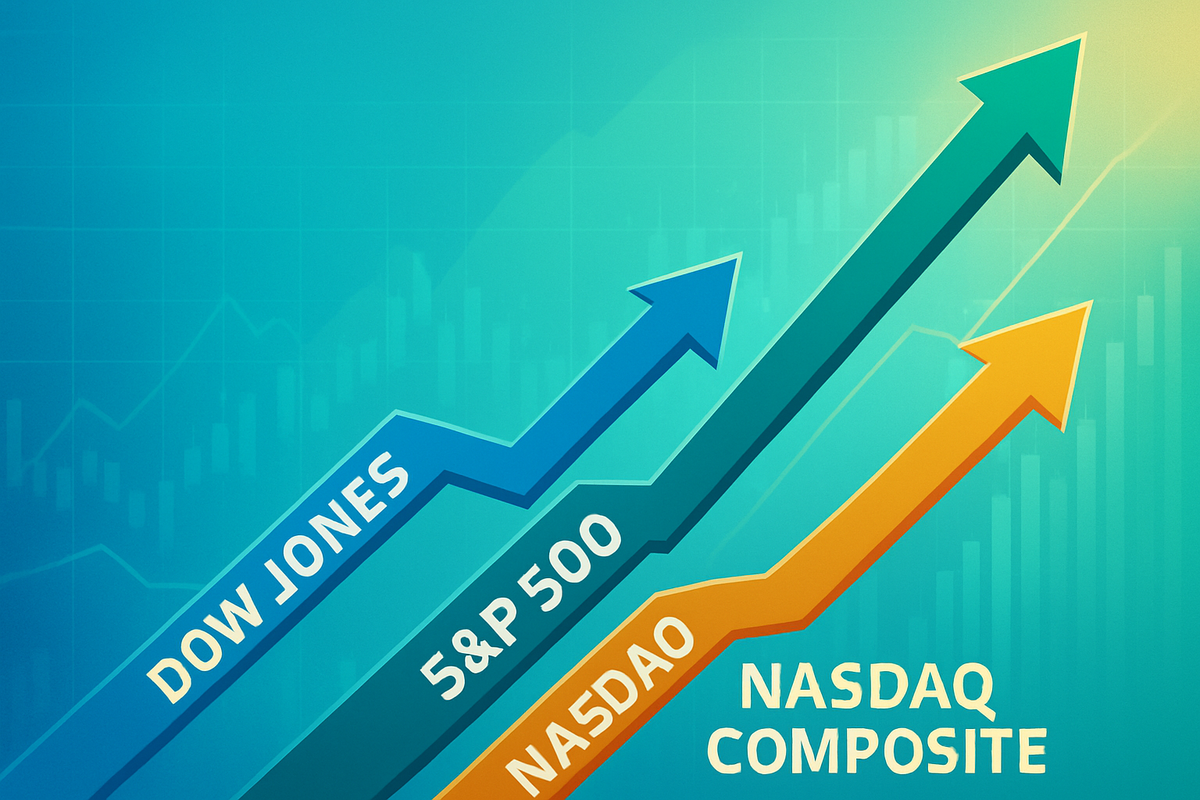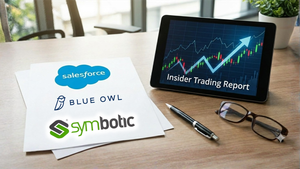
On Friday, October 24, 2025, a wave of optimism swept through global financial markets as the Dow Jones Industrial Average (DJIA), S&P 500 (SPX), and Nasdaq Composite (IXIC) all achieved new record highs. This historic surge was triggered by the release of a milder-than-expected Consumer Price Index (CPI) report for September 2025, which significantly bolstered investor confidence in the Federal Reserve's path toward interest rate cuts. The immediate implication is a renewed belief in a 'soft landing' for the economy, where inflation cools without stifling growth, setting a bullish tone for the coming weeks.
The benign inflation data, despite the backdrop of an ongoing U.S. government shutdown, provided a much-needed catalyst for markets, reinforcing expectations that the Federal Reserve will implement its second consecutive 25-basis-point rate reduction at its upcoming meeting. This development suggests a shift towards more accommodative monetary policy, which typically provides a tailwind for equity markets and could usher in a period of sustained growth. Investors are now keenly watching for further signals from the Fed, anticipating a potentially less restrictive financial environment.
Detailed Coverage: A Closer Look at the Market's Ascent
The market's jubilant reaction on October 24, 2025, was a direct response to the September CPI report, which indicated that inflationary pressures were easing more rapidly than economists had forecast. The report, delayed by nine days due to an ongoing U.S. government shutdown, painted a picture of moderating price increases, fueling expectations for continued monetary policy easing by the Federal Reserve.
Specifically, the headline CPI (year-over-year) rose by 3.0%, falling below the 3.1% consensus forecast from Dow Jones Newswires and The Wall Street Journal. While still above the Fed's 2% target, this marked a deceleration from the previous month's 2.9% and was the highest annual rate since January. More critically, the core CPI, which excludes volatile food and energy prices, also showed signs of cooling, rising 3.0% year-over-year, slightly less than the 3.1% recorded in August and below economists' predictions. On a month-over-month basis, both headline and core CPI figures came in lower than anticipated, at 0.3% and 0.2% respectively, signaling a broad-based easing of price pressures.
The timeline leading up to this moment has been characterized by persistent inflation concerns throughout 2024 and early 2025, prompting aggressive rate hikes by the Federal Reserve. However, recent months have shown a gradual decline in inflation, culminating in the Federal Reserve's first rate cut in September 2025. This latest CPI report solidified the market's conviction that the Fed's tightening cycle is firmly in the rearview mirror, with further cuts on the horizon. Key stakeholders involved include the Federal Reserve, whose monetary policy decisions are paramount, and investors across all asset classes, who are recalibrating their portfolios based on the shifting economic landscape. Initial market reactions were overwhelmingly positive: the Nasdaq (IXIC) surged 1.1%, the S&P 500 (SPX) climbed 0.9%, and the Dow Jones Industrial Average (DJIA) advanced 0.8% in early trading, all setting fresh record highs. Bond markets also reacted, with the 10-year Treasury yield falling to 3.99%, and the U.S. dollar index (DXY) slipping to 98.89, reflecting reduced safe-haven demand amidst improving economic sentiment and lower rate expectations.
Companies Poised for Gains and Losses Amidst Shifting Tides
The latest inflation data and the subsequent market rally are creating distinct winners and losers across various sectors, primarily driven by the prospect of lower interest rates and sustained economic growth. Technology and growth stocks, often sensitive to interest rates due to their future earnings potential, are among the biggest beneficiaries. Companies like Intel (NASDAQ: INTC), which reported robust quarterly results, saw its shares surge by 6%. Similarly, Ford Motor (NYSE: F) experienced a remarkable 7% jump after delivering strong earnings, indicating that consumer demand remains resilient even in a period of economic adjustment. Consumer staples giant Procter & Gamble (NYSE: PG) also saw its stock rise by 2% following better-than-expected earnings, suggesting that even defensive sectors can thrive in an environment of easing inflation and stable consumer spending. These companies benefit from lower borrowing costs, which can reduce their operational expenses and fund expansion, and from increased consumer confidence, which translates into higher sales.
Conversely, some companies and sectors might face headwinds. While the overall market sentiment is positive, companies that have benefited from higher interest rates, such as certain financial institutions or those with significant debt, might see their advantage diminish. Furthermore, companies with valuations heavily reliant on aggressive growth projections that might not materialize could be vulnerable if the economic slowdown is more pronounced than currently expected. For instance, while not directly impacted negatively by the CPI report itself, companies like UGG parent Deckers Outdoor (NYSE: DECK) saw their stock prices decline on earnings, illustrating that individual company performance and sector-specific challenges can still influence outcomes despite broader market positivity. Additionally, gold miners like Newmont (NYSE: NEM) might see some pressure as the appeal of safe-haven assets diminishes with a more optimistic economic outlook and a potentially weaker dollar, though inflation itself can be a positive for gold in the long term. The key takeaway for investors is to identify companies with strong fundamentals, manageable debt, and clear growth strategies that can capitalize on a lower-rate environment and stable economic expansion.
Wider Significance: A Shift in the Economic Paradigm
This milder-than-expected CPI reading and the subsequent market surge represent a significant turning point in the broader economic landscape. For months, the specter of persistent inflation has hung over global markets, dictating central bank policies and investor sentiment. The latest data suggests that the aggressive monetary tightening implemented by the Federal Reserve has successfully begun to rein in price pressures without pushing the economy into a deep recession, aligning with the highly sought-after "soft landing" scenario. This event fits into a broader trend of central banks globally grappling with post-pandemic inflation, and the U.S. success could offer a blueprint for others.
The ripple effects of this development are extensive. Competitors and partners across various industries will need to re-evaluate their strategies. Companies that postponed investment or expansion plans due to high borrowing costs may now find a more favorable environment. For example, the housing market, heavily impacted by elevated mortgage rates, could see a revitalization as interest rates decline, benefiting homebuilders, real estate companies, and related industries. Furthermore, the easing of U.S.-China trade tensions, highlighted by the announcement of an upcoming meeting between President Trump and President Xi, further tempers broader risk aversion and could lead to increased global trade and investment, positively impacting multinational corporations.
Regulatory and policy implications are also substantial. A sustained period of lower inflation and stable growth could alleviate pressure on policymakers to intervene with fiscal measures, potentially leading to a more balanced approach between monetary and fiscal policy. Historically, periods of declining inflation followed by interest rate cuts have often ushered in prolonged bull markets, as seen in various cycles throughout the late 20th and early 21st centuries. While every economic cycle is unique, the current situation draws comparisons to periods where the Fed successfully navigated inflationary pressures, setting the stage for robust economic expansion. The immediate challenge, however, remains the ongoing U.S. government shutdown, which, despite the positive market reaction to CPI, introduces an element of political uncertainty that could temper long-term optimism if unresolved.
What Comes Next: Navigating the Path Forward
The immediate future for financial markets hinges significantly on the Federal Reserve's actions. With the milder CPI reading, a 25-basis-point interest rate cut at the Fed's upcoming meeting next week is now almost a certainty, marking the second consecutive reduction. Short-term possibilities include continued market buoyancy, especially if the Fed's rhetoric remains dovish and indicates further easing is on the table. Technology and growth stocks, having led the recent rally, could see sustained momentum as investors rotate back into these sectors, confident that lower discount rates will boost their valuations. However, any unexpected hawkish comments from the Fed or a resurgence in inflation data could quickly temper this optimism.
In the long term, the prospects appear brighter, but not without potential challenges. A sustained period of lower interest rates could spur corporate investment and consumer spending, fostering economic expansion. This environment could lead to strategic pivots for many companies, focusing on capital expenditure, mergers and acquisitions, and innovation, all of which become more attractive with cheaper financing. Market opportunities may emerge in sectors that have been suppressed by high rates, such as real estate, utilities, and infrastructure. Conversely, potential challenges include the risk of asset bubbles if liquidity becomes excessive, or the possibility of a global economic slowdown impacting export-oriented companies. Investors should also watch for any signs that the government shutdown begins to have a more tangible impact on economic activity beyond just data delays. Potential scenarios range from a 'goldilocks' economy with low inflation and steady growth, to a renewed battle with inflation if global supply chains face new disruptions or geopolitical tensions escalate.
Wrap-Up: A New Chapter for the Markets
The record-setting performance of the Dow Jones, S&P 500, and Nasdaq following a milder-than-expected CPI inflation reading marks a pivotal moment for financial markets. The key takeaway is a significant recalibration of interest rate expectations, with the market now firmly anticipating a more accommodative stance from the Federal Reserve. This shift provides a powerful tailwind for equity markets, fostering a renewed sense of optimism that the economy can achieve a soft landing, avoiding a severe downturn while bringing inflation under control.
Moving forward, the market's trajectory will be heavily influenced by the Federal Reserve's upcoming decisions and future inflation data. While the immediate outlook is positive, investors should remain vigilant. The ongoing U.S. government shutdown, though not overshadowing the CPI news, represents an underlying risk that could introduce volatility if prolonged. Furthermore, global economic conditions, geopolitical developments, and corporate earnings reports will continue to play crucial roles in shaping investor sentiment.
The lasting impact of this event could be the ushering in of a new chapter for the markets, characterized by lower borrowing costs and potentially sustained economic growth. Investors should watch for further indications of inflation trends, the Federal Reserve's forward guidance on interest rates, and the resolution of the government shutdown. Companies with strong balance sheets and adaptable business models are best positioned to capitalize on this evolving landscape. This period demands a balanced approach, celebrating the current market strength while remaining prepared for potential shifts and uncertainties.
This content is intended for informational purposes only and is not financial advice






